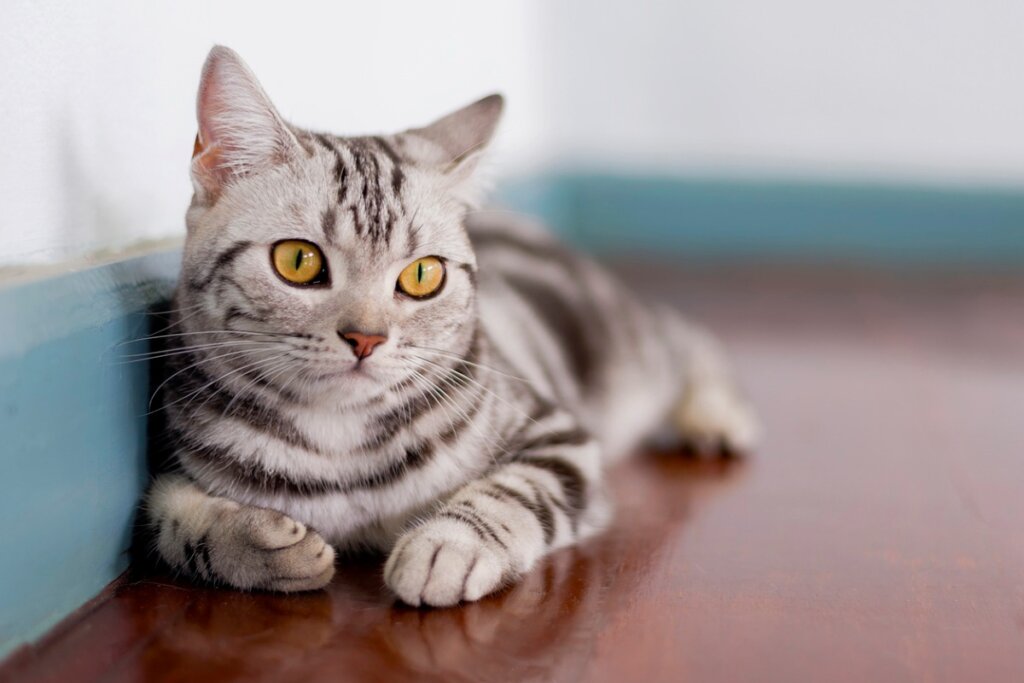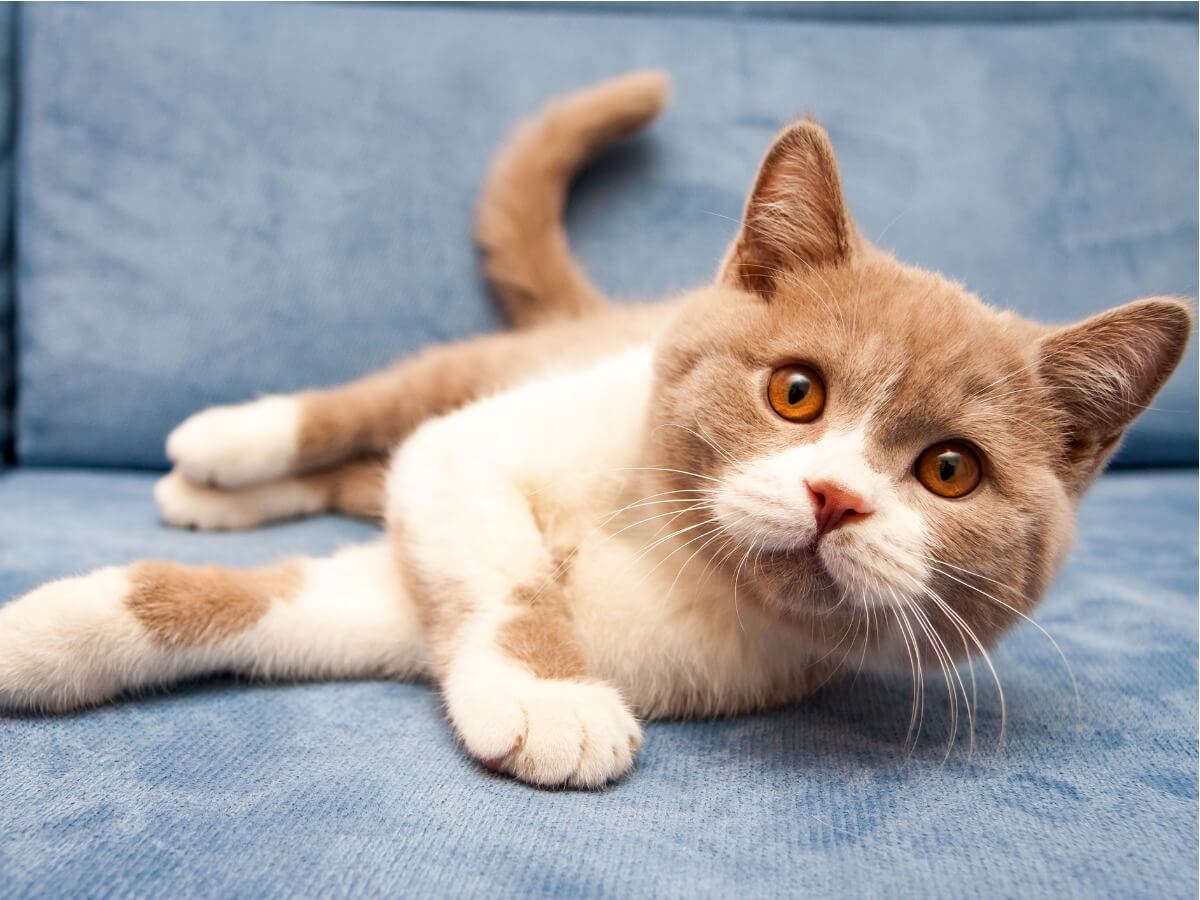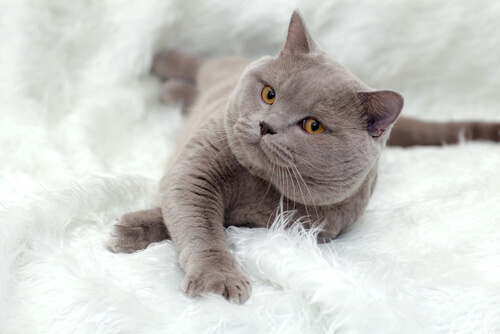All About the British Shorthair Cat

The British Shorthair is one of the most popular cat breeds in the United Kingdom. It’s characterized by a beautiful coat and a deep eye color, which give it a cute and quite striking appearance.
It’s quite gentle and peaceful, and, in addition, its coat has a lot of variations that can please even the most demanding people. Keep reading to find out everything you need to know about this curious animal.
Origin of the British Shorthair
The British Shorthair has its origin in a group of felines imported from Egypt by the Romans, just when they invaded Great Britain. From that time on, cat lovers looked after this breed, and bred it. However, it wasn’t until the 1870s that the first formal specimens of the British Shorthair were introduced.
With the advent of World War I and World War II, the breeding of these felines declined so much that it was on the verge of disappearing. Although cat production resumed at the end of the conflicts, the population was so small that there were fears for the health and genetic stability of the breed.
In an attempt to encourage genetic variation and improve the appearance of the British Shorthair, it was crossed with both Persian and Carthusian cats. As a result, new variants appeared with different colors, longer coats. This gave rise to a new breed called British Longhair which is the closest relative of the British Shorthair.

Main characteristics
The most remarkable characteristic of the British Shorthair cat is its bulky, fluffy coat that surrounds its body. This gives it a plush appearance that resembles that of a bear, with large eyes that sometimes have deep, striking colors. In addition, its features are more rounded than those of other felines, which enhances its cuddly appearance.
The British Shorthair has a medium-sized, muscular and compact body. Its limbs are a little short, but strong enough to make long, high jumps. The coloration of this feline is extremely diverse and is divided into several types according to their coloration pattern. Among the most common are the following:
- Colorpoint. The color of the eyes: blue or gray eyes and a light coat with dark extremities. The combination of shades may vary.
- Tabby. Brindle color pattern.
- Chinchilla. The hair has two colorations, near the skin is white or silver, while at the tip there are black or dark shades.
- Harlequin White coat. The body has a white coat with a few dark-colored spots. Only about one-sixth of its entire body is colored.
- Van. The coat is of one color only. White is the most frequent.
- Tortie. Tricolor coat.
Behavior
In general, the British Shorthair cat is famous for being affectionate, sociable, and peaceful. They love to spend time with their owners, and so they tend to tease them for attention. They aren’t very active and prefer to lie down rather than engage in any activity. Because of this, they don’t get to enjoy playing as much as other felines.
This cat’s calm and sociable attitude makes it a good choice for the family. It can even get along well with children or other pets in the home. However, it also needs its space to rest and recover from interactions.
Care of the breed
This breed doesn’t require special care, except for the maintenance of its coat. Usually, a thorough brushing 2 to 3 times a week will be enough to avoid knots and remove loose hair. In fact, the feline usually likes this process, so it won’t be difficult to get them to stay still.
Perhaps the biggest problem you can have with the British Shorthair cat is its tendency to be sedentary. Such behavior is conducive to weight gain and obesity, which will eventually lead to other health complications. To prevent this, try to play with them for short periods during the day.
You’ll also have to provide them with toys, scratching posts, and towers that they can climb, as this will encourage their curiosity and they’ll do some physical activity. Also, try to get them a playmate (human or feline) to accompany them during the day. This way, they won’t get bored so easily and will develop their social behavior well.
British Shorthair Cat health
Although most of them don’t have many health problems, the breed is susceptible to certain congenital ailments. Primarily, attention should be paid to the following pathologies:
- Hypertrophic cardiomyopathy: This causes a thickening of the heart muscle that reduces the efficiency of blood pumping. About 9% of British Shorthair cats have this disease.
- Hemophilia B: A disorder that prevents blood from clotting properly.
- Polycystic kidney disease: As the name implies, this is the presence of several cysts within the kidneys that grow over time.
Hereditary diseases are impossible to prevent and to cure, so it’s recommended to consult with the breeder about the health problems that the specimens have. Likewise, the feline must go to the veterinarian at least once every 6 months for a check-up. This will help to detect any complications that may appear and to act as soon as possible.

As you can see, the British Shorthair is an amazing and beautiful cat breed that adapts well to home life. If you’re looking for a charismatic, sociable, and loving cat, you can be sure that this breed will meet your expectations and even exceed them.
All cited sources were thoroughly reviewed by our team to ensure their quality, reliability, currency, and validity. The bibliography of this article was considered reliable and of academic or scientific accuracy.
- Dunner, S. (2014). GENÉTICA DE PERROS Y GATOS: PATOLOGÍAS HEREDITARIAS Y OTROS ASPECTOS DE INTERÉS EN LA CLÍNICA VETERINARIA. Canis et Felis, 129, 98-116.
- The International Cat Association. (2021). British Longhair & British Shorthair Breeds. Recuperado el 4 de julio de 2022, disponible en: https://www.tica.org/Breed_Introductions/British_Long_and_Shorthair_for_Website.pdf
- Australian Cat Federation. (2017). BRITISH SHORTHAIR [BRI] (Standard Source: FIFe 1987). Recuperado el 4 de julio de 2022, disponible en: https://www.catsgccfv.org.au/images/notices/files/Group%203/2017_British_Shorthair.pdf
- Granström, S., Nyberg Godiksen, M. T., Christiansen, M., Pipper, C. B., Willesen, J. T., & Koch, J. (2011). Prevalence of hypertrophic cardiomyopathy in a cohort of British Shorthair cats in Denmark. Journal of veterinary internal medicine, 25(4), 866-871.
